Letters from Lodi
An insightful and objective look at viticulture and winemaking from the Lodi
Appellation and the growers and vintners behind these crafts. Told from the
perspective of multi-award winning wine journalist, Randy Caparoso.
Direct influence of east vs. west side terroirs on the taste of Lodi Zinfandels
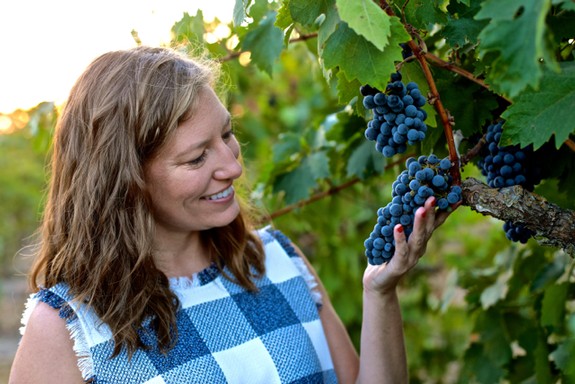
Lodi Winegrape Commission's Stephanie Bolton with cluster of 2018 Steacy Ranch Zinfandel (planted in 1907) on Mokelumne River-Lodi's east side
The French call it terroir – a “sense of place” reflecting each vineyard’s unique soil, climate, aspect and overall topography, which is reflected on how vines grow, their resulting grape clusters, and ultimately in the wines coming from those grapes.
Terroir explains why wines from certain vineyards and regions have sensory qualities that are different from wines grown in other vineyards and regions. And yes, there are terroir related distinctions in the wines of Lodi – even those made from grapes as familiar to us as Zinfandel.
More and more, local winemakers have been talking about “east side” Lodi Zinfandels being different from “west side” Lodi Zinfandels. The dividing line is generally thought to be U.S. Route 99 – although more accurately, the unofficial demarcation is the historic Southern Pacific Railroad tracks (now owned by Union Pacific Railroad) running north-south through the City of Lodi – which puts Zinfandels from vines growing in the vicinity of the Victor, Lockeford and Clements communities on the east side, and Zinfandels growing between Wine & Roses Hotel, Woodbridge and Interstate 5 on the west side.
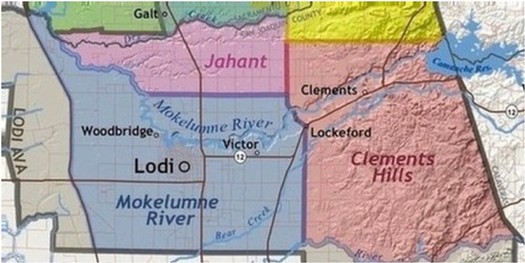
The Lodi Viticultural Area's Mokelumne River, Jahant and Clements Hills appellations
Generally speaking, all the best and oldest Zinfandel vineyards in Lodi are planted on sandy loam soils in the Tokay Series. However, old-time and new-time Lodi vintners alike know that the soils on the east side are significantly sandier than soils on the west.
In terms of vigor: Zinfandel grown along W. Turner Rd. or near Jessie’s Grove Winery on the west side, for instance, sit on sandy soils with a rich mixture of dark, organic loam; whereas Zinfandel grown along Alpine Rd. or Bruella Rd. near Victor are rooted in soil that is less vigorous and sandier to the point of being practically like soft, white beach sand. On hot days, you almost want to lay down a beach blanket and play Frankie Avalon and Annette Funicello songs.
So how does that affect grapes? Here is a photo of Zinfandel clusters from four Lodi vineyards taken this past September 2018, right before the grapes were harvested:
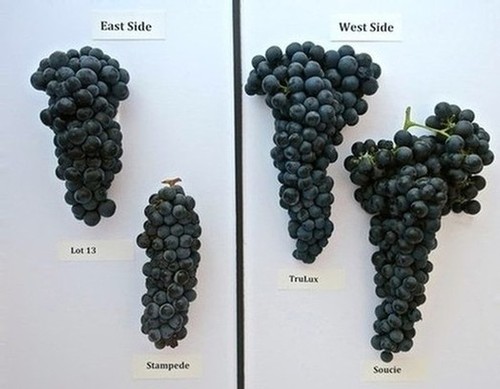
While berry sizes in all but the Stampede Vineyard sample are fairly proportionate, the biggest difference is in the size and weights of the clusters as a whole:
• West side vineyards produce Zinfandel bunches nearly double the size of east side vineyards.
• Berry size is smallest in the Stampede Vineyard because it is located in a riverside site near Clements where the soils are even more depleted than in vineyards near Victor (such as the Lot 13 Vineyard), with an ultra-fine, powdery sandy loam – hence, the tiniest bunch.
• The west side vineyards of TruLux (located just south of Van Ruiten Family Winery) and Soucie (located barely an eighth of a mile from I-5) have richer and loamier sandy soils, thus resulting in larger clusters with bigger berries.
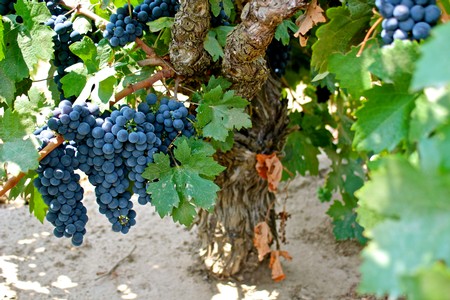
Generous sized Zinfandel clusters growing in Soucie Vineyard (planted in 1916) on Mokelumne River-Lodi's far west side
How does this affect the wines? Because of the elevated skin-to-juice ratio found in the smaller clusters grown in Stampede, Zinfandels from this vineyard tend to have a zestier quality of acidity along with a firmer, dryer tannin feel – yet are very pretty in black or red cherry fruit qualities.
Zinfandels from Lot 13 Vineyard are typical of east side wines, which generally tend to have
• More pronounced floral, red berry/cherry fragrances and fruit profiles
• More pronounced, zesty acidity, adding to a more structured, delineated feel on the palate
• Slightly less weight or overt sense of “body” than west side Zinfandels.
By way of contrast, Zinfandels from west side vineyards such as TruLux and Soucie tend to be
• Fuller in body
• Softer or rounder in feel
• Very plump in often jammy fruit qualities suggesting black as well as red berry qualities
• Often earthy or loamy in aromas and flavors, qualities rarely found in east side Zinfandels.
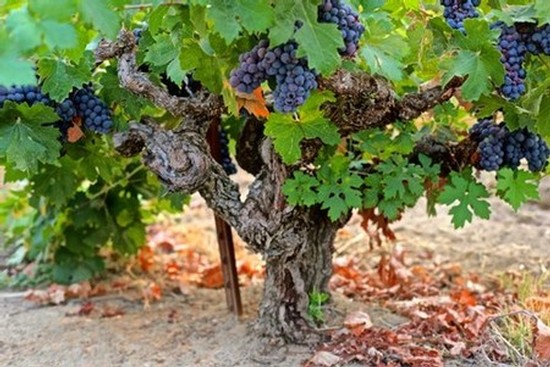
Smaller cluster morphology typical of east side grown Zinfandel (Süss Vineyard, planted during the 1920s in Clements Hills-Lodi)
While west side Zinfandels may not be quite as zesty or flowery as their east side counterparts, and east side Zinfandels may not be as full bodied or sumptuous in fruit qualities as their west side counterparts, Lodi Zinfandels from both sides of the track usually end up being delicious and interesting in their own way.
Needless to say, sometimes manifestations of “east vs. west” side styles overlap in individual wines. Mettler Family Vineyards, for instance, produces an east side grown Lodi Zinfandel that is as generously fruited and full bodied as any grown on the west side; not in the least because there is also a good percentage of Petite Sirah (a grape with more intrinsic tannin than Zinfandel) blended into the wine, plus a generous “toasted” oak aging regime contributing further to a sense of fullness. Winemaking decisions matter.
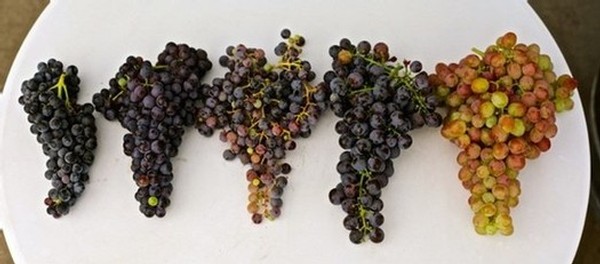
Field mix grown in Jessie's Grove's Royal Tee Vineyard going into Alquimista Cellars Zinfandel: (from left) Zinfandel, Carignan, Mission, Black Prince and Flame Tokay grapes
Alquimista Cellars (based in Sebastopol, Sonoma County) fashions a west side grown Lodi Zinfandel from Jessie’s Grove’s 1889 vines that is perfumed with red fruit qualities, has distinct acid delineations and is very restrained in body and tannin – thus, tasting very “east side.” But that is largely because the wine is co-fermented with a good proportion of Carigan, Mission, and even Tokay and Black Prince grapes (all growing in this historic Zinfandel block) which lightens the weight of the wine considerably, and also because the wine goes through a whole berry/partial whole cluster fermentation imparting more floral, fragrant fruit qualities resulting from carbonic maceration (i.e. intracellular fermentation taking place within the whole berries prior to primary fermentation).
That said, excellent examples of these different Zinfandels that can be found locally or nearby:
EAST SIDE
► McCay Cellars, Lot 13 Vineyard (Mokelumne River) mccaycellars.com
► Klinker Brick Winery, Marisa Vineyard (Mokelumne River) klinkerbrickwinery.com
► Harney Lane Winery, Lizzy James Vineyard (Mokelumne River) harneylane.com
► Harney Lane Winery, Scottsdale Vineyard (Mokelumne River)
► Ironstone Vineyards, Rous Vineyard Reserve (Mokelumne River) ironstonevineyards.com
► Fields Family Wines, Stampede Vineyard (Clements Hills) fieldsfamilywines.com
► Tizona by Bokisch Vineyards, Süss Vineyard (Clements Hills) bokischvineyards.com
► Oak Farm Vineyards, Hohenrieder Vineyard (Jahant) oakfarmvineyards.com
► Michael Klouda Wines, 1902 (Mokelumne River) drinkmkwines.com
► Peirano Estate, The Immortal Zin (Mokelumne River) peirano.com
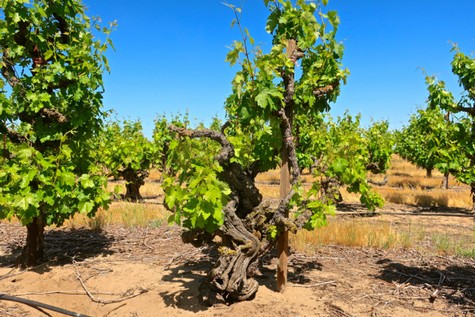
This past April 2019 on Mokelumne River-Lodi's east side, ancient Zinfandel (planted in 1904) in Lizzy James Vineyard alongside interplanting of younger vines (planted in the 1970s)
WEST SIDE
► St. Amant Winery, Marian’s Vineyard (Mokelumne River) stamantwine.com
► m2 Wines, Soucie Vineyard (Mokelumne River) m2wines.com
► PRIE Winery, Soucie Vineyard (Mokelumne River) priewinery.com
► McCay Cellars, TruLux Vineyard (Mokelumne River)
► The Lucas Winery, ZinStar Vineyard (Mokelumne River) lucaswinery.com
► Jessie’s Grove Winery, Royal Tee Vineyard (Mokelumne River) jessiesgrovewinery.com
► Jessie’s Grove Winery, Westwind Vineyard (Mokelumne River)
► Oak Farm Vineyards, Mohr-Fry Vineyard (Mokelumne River)
► Lodi Native by Maley Bros., Wegat Vineyard (Mokelumne River) woodbridgeuncorked.com
► Stellina by Estate Crush (Mokelumne River) estatecrush.com
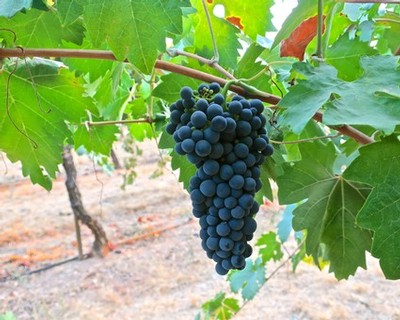
Typically moderate sized, loosely bunched Zinfandel growing in Hohenrieder Vineyard on Lodi's east side (Jahant AVA)
And stellar examples of Lodi grown Zinfandel produced outside the region that can be sourced online or through other means:
EAST SIDE
► Turley Wine Cellars, Steacy Ranch (Mokelumne River) turleywinecellars.com
► Turley Wine Cellars, Kirschenmann Vineyard (Mokelumne River)
► Turley Wine Cellars, Dogtown Vineyard (Clements Hills)
► Neyers Vineyards, Vista Luna Vineyard (Clements Hills) neyersvineyards.com
► Maître de Chai, Stampede Vineyard (Clements Hills) mdc.wine
WEST SIDE
► Alquimista Cellars, Jessie’s Grove Vineyard (Mokelumne River)
► Mikami Vineyards (Mokelumne River) mikamivineyards.com
► Six Hands Winery, Cusumano Ranch (Mokelumne River) sixhandswinery.com
Our suggestion? Open a bottle of an east side Lodi Zinfandel and taste it next to a west side Lodi Zinfandel. Sometimes the differences are subtle, or barely noticeable; but often the differences are obvious, even dramatic. Either way, it’s good to know that not all Lodi grown Zinfandels are cut from the same cloth. They taste like where they come from.
Vive la différence!
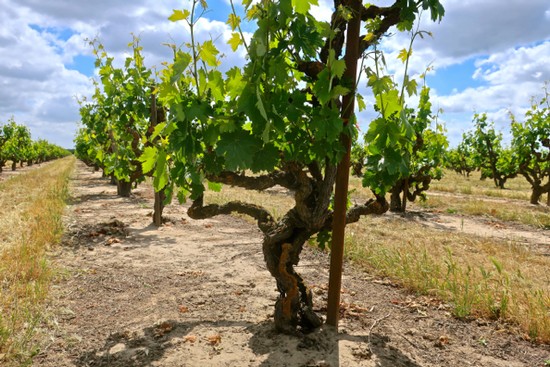
This past April 2019, creaky kneed ancient vine Zinfandel (planted in 1901) in Marian's Vineyard on Mokelumne-Lodi's west/south side